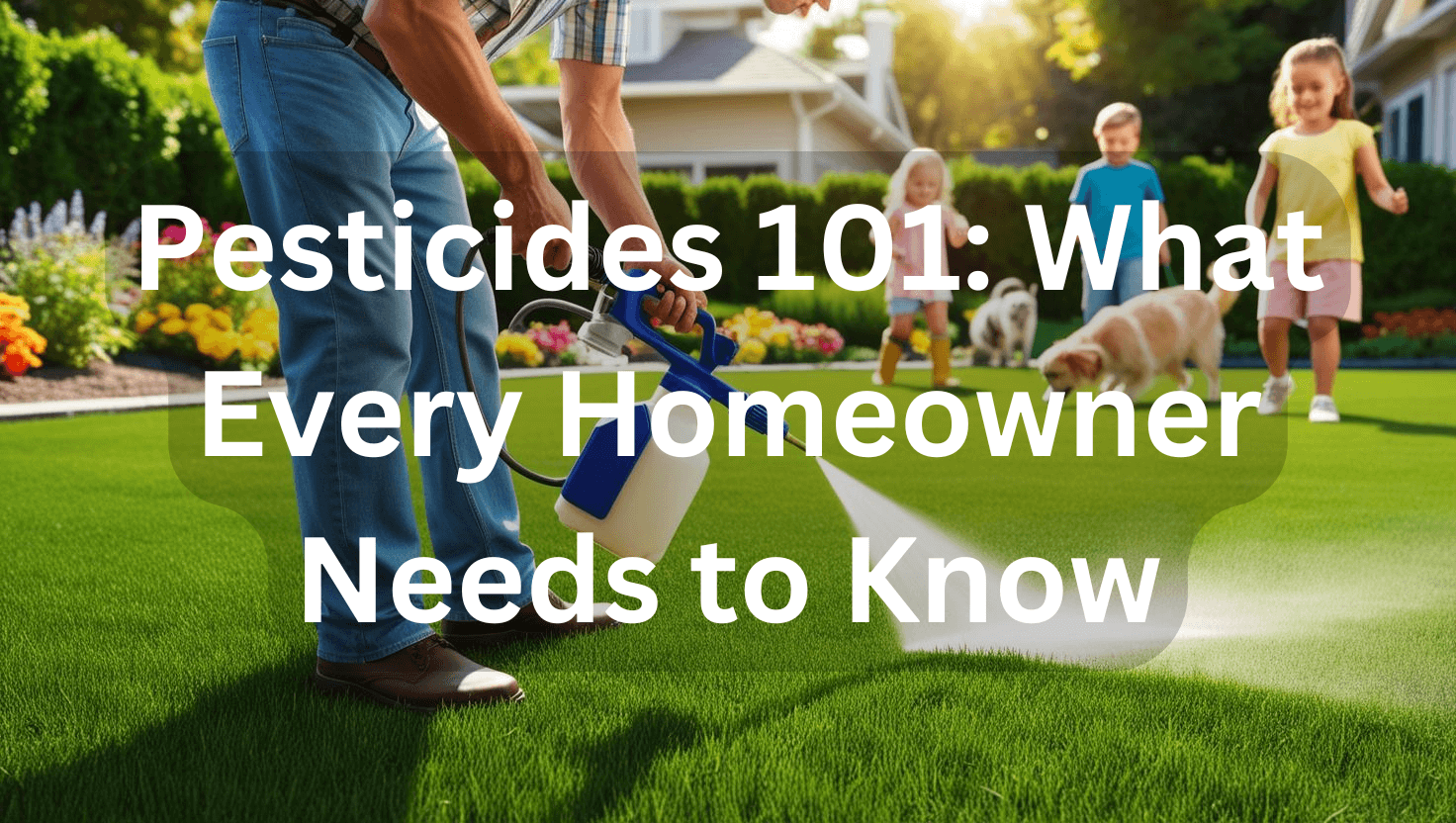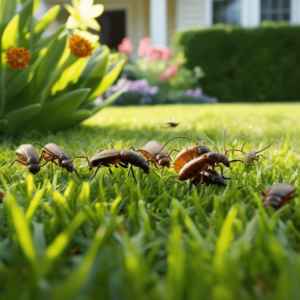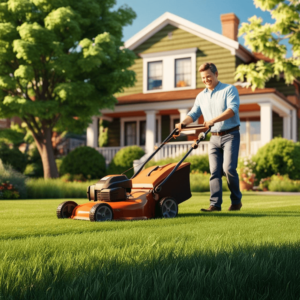Pesticides 101: What Every Worried Homeowner Needs to Know

Maintaining a lush, healthy lawn often involves combating weeds, pests, and diseases—but at what cost? Many homeowners turn to pesticides to address these challenges, yet the use of these chemicals can raise concerns, especially for families with children and pets.
In this blog post, we’ll explore what pesticides are, the various types commonly used in home lawn care, and, most importantly, how to make safer choices for your loved ones. Whether you’re looking to reduce chemical exposure or simply understand your options better, this guide will help you create a beautiful yard while prioritizing safety and sustainability.
What are Pesticides?
A pesticide is defined by the Environmental Protection Agency (EPA), as any substance or mixture of substances intended for preventing, destroying, repelling, or mitigating any pest.
Pesticides are chemical or biological substances designed to control, prevent, or eliminate unwanted organisms that can harm plants, including weeds, insects, fungi, and rodents. These products come in various forms such as sprays, granules, and powders, and work by either killing the target pest or disrupting its ability to feed, grow, or reproduce.
How do pesticides work?
Pesticides work by interfering with essential biological processes in target organisms, ultimately preventing their growth or causing their death. Each type of pesticide is specifically formulated to disrupt different biological systems, making them effective against particular types of pests while ideally minimizing harm to beneficial organisms.
Pesticides function by targeting and disrupting specific biological processes within pest organisms, such as nervous system function, cell membrane development, or enzyme production. These chemicals can work either through direct contact with the pest or systemically through absorption into plant tissues, ultimately preventing pest growth or causing death.
The Specific Science Behind Pesticides
The most common mechanisms involve attacking the pest’s nervous system, disrupting cell membrane function, or interfering with vital enzyme production. For example, many insecticides work by blocking nerve signals in insects, leading to paralysis and death, while herbicides often work by preventing specific plant proteins from functioning properly.
Contact pesticides kill pests immediately upon direct exposure, working through absorption through the skin or exoskeleton. Systemic pesticides, on the other hand, are absorbed by plants and move throughout their tissue, making the entire plant toxic to any pest that tries to feed on it.
Some modern pesticides are designed with selective toxicity, meaning they target specific biological processes unique to certain pests while having minimal impact on other organisms. This selective approach helps explain why some newer pesticides can effectively control unwanted weeds while leaving your grass unharmed.
Common Types of Pesticides in Home Lawn Care
Home lawn care often requires different types of pesticides to address specific challenges, from controlling pesky weeds to preventing diseases that damage grass. Understanding the purpose and function of each type can help you choose the right products while minimizing risks to your family and pets.

Insecticides
Insecticides are pesticides designed to kill or repel insects that feed on or damage your lawn. They target pests like grubs, ants, and beetles, either by affecting their nervous systems or acting as growth inhibitors.
Herbicides
Herbicides are used to control unwanted plants or weeds that compete with grass for nutrients, sunlight, and water. They are often classified as selective, which target specific weeds, or non-selective, which kill all vegetation they contact.
Fungicides
Fungicides combat fungal diseases like brown patch, dollar spot, and powdery mildew, which can weaken or kill your grass. These pesticides work by either preventing fungal spores from germinating or stopping existing fungi from spreading.
Rodenticides
Rodenticides are used to control rodents like moles or voles, which can damage lawns by tunneling and feeding on roots. They often contain bait to attract these pests and cause death through ingestion.
Biological or Natural Pesticides
Biological pesticides use natural organisms or compounds, like bacteria or plant-based oils, to control pests in a safer, eco-friendly way. These are especially popular for homeowners seeking alternatives to synthetic chemicals.
Common Concerns About Using Pesticides in Lawn Care
While pesticides can be effective in maintaining a healthy lawn, many homeowners are hesitant to use them due to potential risks, especially for families with pets and children. The fear of exposure to harmful chemicals and their long-term effects often prompts homeowners to seek safer alternatives.
Risks to Children
Children are more vulnerable to pesticides because of their smaller body size and tendency to play on the ground, where exposure to treated surfaces is higher. Studies have raised concerns about links between pesticide exposure and developmental or health issues, making safety a top priority for parents.

Risks to Pets
Pets are also at risk, as they can absorb pesticides through their paws, lick treated grass, or ingest granules accidentally. Certain chemicals may cause immediate reactions like vomiting or long-term health problems such as liver damage.
Environmental Concerns
Pesticides don’t just stay on your lawn; they can run off into waterways, harm beneficial insects, or disrupt local ecosystems. Homeowners concerned about sustainability may worry about how the pesticides they use in their yard affect the environment.
How homeowners can mitigate risks while still maintaining a healthy lawn
For homeowners concerned about the safety of pesticides, there are practical steps you can take to protect your family and pets while keeping your lawn healthy. By making thoughtful choices and adopting safer practices, you can minimize risks without sacrificing the beauty of your yard.
Below are five effective strategies to achieve a balance between pest control and creating a safe outdoor space for everyone to enjoy.
Choosing Safer Pesticides
When selecting pesticides, look for products specifically labeled as safe for use around pets and children. These labels often include certifications from trusted organizations or terms like “non-toxic,” “natural,” or “biodegradable.”
Pay attention to the active ingredients in the product, as some chemicals, like pyrethrins or diatomaceous earth, are less harmful than others. Avoid pesticides containing ingredients such as organophosphates or carbamates, which are known to pose higher risks to humans and animals.
Opt for products that target specific pests rather than broad-spectrum pesticides, which can harm beneficial insects and the environment. Narrow-target solutions minimize unnecessary exposure and help maintain a balanced ecosystem in your yard.
Finally, consider using Integrated Pest Management (IPM) principles, which prioritize prevention and non-chemical methods before resorting to pesticides. This approach reduces the need for repeated treatments and ensures the safety of your family and the environment.
Organic and Natural Lawn Care
Organic and natural lawn care relies on non-chemical methods to control pests and maintain healthy grass. Products like neem oil, insecticidal soaps, or biological agents such as Bacillus thuringiensis (Bt) are effective alternatives to synthetic pesticides.
Incorporating pest-resistant grass varieties or companion planting can naturally reduce the presence of weeds and harmful insects. For example, clover is often added to lawns to enrich soil health and crowd out undesirable plants.
Preventive Lawn Maintenance

A healthy lawn is less susceptible to pests and diseases, reducing the need for pesticide use. Regular tasks like aerating soil, overseeding, and maintaining proper watering practices can strengthen grass and prevent bare patches where weeds thrive.
Mowing your lawn at the right height and frequency helps prevent weed growth and pest infestations. Taller grass can shade the soil, discourage weed seeds from sprouting, and support a more resilient lawn ecosystem.
Creating Buffer Zones
Establish untreated buffer zones or play areas in your yard to give children and pets a safe space free from pesticide exposure. These can include designated zones with untreated grass or paved spaces for play equipment.
You can also use physical barriers like mulch, gravel, or fences to create clear boundaries between treated and untreated areas. This ensures that pesticides stay where they are needed while protecting areas used by your family and pets.
Timing and Application Best Practices
Apply pesticides when children and pets are not present, and follow label instructions carefully to minimize risks. Many products specify a safe waiting period before re-entering treated areas—adhere to these guidelines to protect your family.
Consider applying pesticides during early morning or late evening when winds are calmer to avoid accidental drift. Use targeted application methods, like spot treatments, to limit pesticide use to the areas that need it most.
What to Remember
As discussed throughout this post, pesticides play a crucial role in maintaining lush, pest free lawns, but they can also raise concerns for families with children and pets. By understanding what pesticides are and how they work, homeowners can make informed decisions about their lawn care practices.
For those worried about safety, there are many ways to minimize risks while still managing pests effectively. Choosing safer pesticides, exploring organic and natural alternatives, and adopting preventive lawn care practices can go a long way in creating a safe environment.
Ultimately, achieving a healthy lawn doesn’t have to come at the expense of your family’s well-being. With the right approach, you can strike a balance that protects your loved ones, nurtures your yard, and supports a sustainable lifestyle.